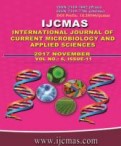


 National Academy of Agricultural Sciences (NAAS)
National Academy of Agricultural Sciences (NAAS)

|
PRINT ISSN : 2319-7692
Online ISSN : 2319-7706 Issues : 12 per year Publisher : Excellent Publishers Email : editorijcmas@gmail.com / submit@ijcmas.com Editor-in-chief: Dr.M.Prakash Index Copernicus ICV 2018: 95.39 NAAS RATING 2020: 5.38 |
The maximum yield potential of Bt cotton is yet to be trapped under irrigated conditions which is low for various reasons. Among the different constraints in cotton major reduction in yield is due to leaf reddening which results in 30-60% of yield loss. Leaf reddening in cotton is also known as red leaf disease (lal patti). This disorder is an outcome of interaction of location, variety, environmental condition and nitrogen, potassium, magnesium etc. supply. In general, some of the hirsutum varieties and a few inter and intra specific tetraploid hybrids are sensitive and vulnerable to this malady. Appearance of red leaf symptom is primarily, due to the accumulation of anthocyanin pigment. Identification of suitable reasons and management of leaf reddening to increase the productivity in cotton is the key for crop potential and hence, the review.
 |
 |
 |
 |
 |